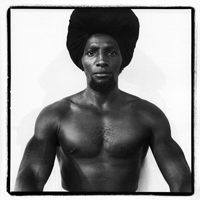JTF (just the facts): A total of 15 black and white photographs, framed in white and matted, and hung in the main gallery space. All of the works are vintage gelatin silver prints, taken between 1973 and 1986. The prints are square format on 20×16 paper, and were not reliably editioned. (Installation shots at right.)
Comments/Context: George Dureau’s 1970s era portraits of muscular black men from New Orleans offer plenty of entry points for discussion, so many that I think the recent dialogue around the work has gotten somewhat misplaced. His photographs are both classical in structure and intimate in nature, capturing both the sculptural forms of the male body and the individual personalities of his sitters. His authentic connection to his models is undeniably visible in these portraits, and this trust is what makes the images durably engaging.
The bodies in Dureau’s photographs range from tight and gangly to thick and burly, with a wide range of bushy afros and dreadlocks as decoration. Perfect athletic muscles flank the deformed bodies of dwarves and amputees, and humanistic beauty is evident in all of them. With an echo of Avedon, his subjects are quietly posed against flat white backgrounds or simple interior walls, focusing the viewer’s attention on the shapes and forms of torsos and full length figures. There is a deliberate use of contrast in nearly all of the images, placing bright white clothing and featureless environments in contrast with the dark skin of the sitters, almost like silhouettes.
There are three lines of critical analysis around this work that I find to be distracting, if not downright misleading. There is the “white man taking photographs of black men” racial angle, the “male nude must mean homoerotic” angle, and the “Mapplethorpe was influenced by Dureau, so that’s why these pictures are important” angle. All three unnecessarily pigeon hole the work into “black photography”, “gay photography” and “Mapplethorpe knock-off photography”, none of which is particulalrly accurate or representative of what the portraits really show us. I think this overly easy tagging of the work also inverts the causality – we should first determine the merits of the photography on its own before we attempt to place it into larger contextual frameworks, not the other way around. As a collector, I can’t really imagine buying one of these portraits and then telling visitors to my home “it’s a George Dureau; he influenced Mapplethorpe” as if that was some kind of logical explanation for why I purchased it. The Mapplethorpe connection is of course interesting in tracing the evolution of visual motifs between the artists, but it wouldn’t matter if the Dureau photographs themselves weren’t accomplished in their own right.
So bypass the critical red herrings that fly around this show and see these images for what they are: well-executed, empathetic, classically-influenced male portraits, distilled down to an essential mix of truth, strength, and vulnerability.

